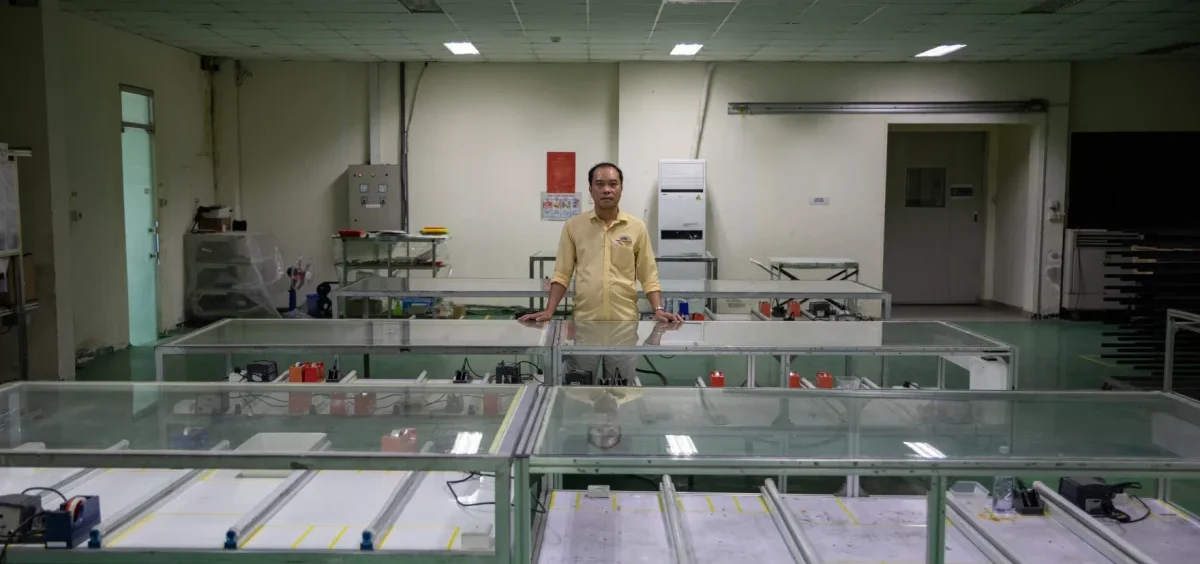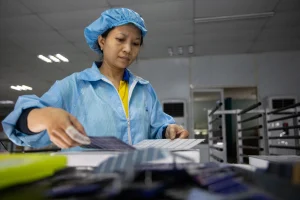News

Southeast Asian solar manufacturers look elsewhere to escape tariffs
By: Leila Goldstein | The Ohio Newsroom
Posted on:
HO CHI MING CITY, Vietnam (The Ohio Newsroom) — About five years ago, orders for panels from one of the solar manufacturers in Southeast Asia, Red Sun Energy, in Ho Chi Minh City, Vietnam were pouring in. But as of August, half of the automated machines were dormant. Thinh Diep, the general manager’s assistant, says the company’s biggest customer was based in California.
That, however, was before the U.S. Department of Commerce started investigating companies in 2022 for allegedly dodging tariffs by moving production from China to Southeast Asia. Then, solar tariffs were reinstated in Vietnam this June.
“They stopped ordering from us because of this tax increase,” Diep said. “It’s just a very bad situation for us.”
A preliminary determination by the department in December 2022 meant that Red Sun, along with other companies, would be subject to these tariffs.
To support green energy, President Biden waived tariffs for solar panels produced in Vietnam, Cambodia, Malaysia, and Thailand for two years starting in 2022. But that exemption came to an end this year.
Red Sun lost around half of its business due to the higher tariffs its U.S. customers would have to pay, according to Diep. He said the company may look to find new clients in Europe, but losing out on sales to the U.S. market is a major blow.
“I feel like we are a necessity to the U.S. market that has been unfairly treated by the government policy,” he said. “We’re just providing products that the U.S. market obviously needs but they are not producing.”
U.S. solar manufacturers, including Ohio-founded First Solar, also filed complaints that led to new duties in October and November. Some Southeast Asian manufacturers are now facing duties of more than 250% on imported solar products.
The burden of these tariffs on foreign solar manufacturers could change the supply chains for solar panels coming to American consumers, and the shape of that industry in the U.S.
Factory shutdowns and moves
Some companies in the region are suspending operations in response to the increased tariffs. The Chinese solar company LONGi, which shares ownership of a manufacturing company in Pataskala, Ohio, paused production at a battery factory in Vietnam in June after tariffs were reinstated.

An eight mile drive further out from the city center, a guard outside New East Solar Energy’s plant says production has slowed since the end of 2023, and the factory is no longer operational. The company was one of five solar manufacturers in Southeast Asia the U.S. Commerce Department determined was circumventing tariffs in August 2023. According to the department, these companies were found to have shipped nearly completed products from China to Southeast Asia for minor changes to avoid paying the taxes on imports.
The guard said the large metal contraptions wrapped in plastic and cloth outside the company warehouses were being shipped to Indonesia, where the company plans to shift operations.
Neither Jintek nor New East Solar immediately responded to requests for comment.
Indonesia is, notably, not subject to these U.S. solar tariffs. Neither is Laos. At least four China-linked projects have started operations in those two countries in the last year and a half, according to Reuters.
A years-long trend
Companies setting up factories in new countries to avoid solar tariffs is nothing new.
“First manufacturing went to Taiwan, and then there were tariffs against imports in Taiwan, and then it went to Southeast Asia and now there are more tariffs,” said Ishana Ratan, a PhD candidate in the Political Science Department at UC Berkeley researching renewable energy.
But she says moving manufacturing to countries without these tariffs, such as Indonesia and Laos, is likely not a feasible strategy in the long term if these companies want to serve the U.S. market.
“The U.S. will almost certainly extend tariffs to those countries,” said Jenny Chase, lead solar analyst at BloombergNEF. “However, the profit margins of selling to the U.S. are currently so high, that I think some companies might do it anyway and say, ‘Well, we might get two years out of this, let’s do it.’”
Another option for these companies is to move production to the U.S. and benefit from large Inflation Reduction Act incentives. The Chinese solar company LONGi and its U.S. partner announced plans to build a factory in Ohio less than a year after President Biden signed the Inflation Reduction Act. The factory 20 miles east of Columbus employs over 1,000 Ohioans and opened earlier this year.
“These manufacturers have had plenty of experience dealing with tariff uncertainties and ultimately, it pays off for them to deal with all of this trade and political risk because the U.S. is by far the most lucrative solar market for solar module makers in the world,” said BloombergNEF analyst Pol Lezcano.
The moves may make sense for foreign manufacturers looking to profit from the U.S. market. But Michael Davidson, assistant professor at UC San Diego School of Global Policy and Strategy, says it calls into question the effectiveness of trade measures designed in part to reduce American reliance on China.
“If [trade policy aimed at decoupling from China] results in Chinese companies manufacturing in the U.S. or setting up shop in Southeast Asia to get around the trade rules, it doesn’t really disconnect our supply chain from China,” said Davidson.
Leila Goldstein is a Pulitzer Center 2024 Richard C. Longworth Media Fellow. Additional reporting and interpretation by Eung Sea.
This is the second story in a three-part series about the impact of solar tariffs on manufacturing overseas and in Ohio. The series was supported by the Pulitzer Center.

